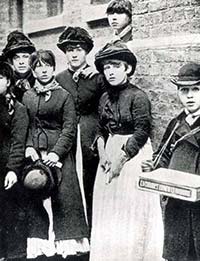Saturday, 4 June 2022
 The Match Girls Strike
The Match Girls Strike
Speaker: Michael Astrop
At the Todmorden u3a members meeting on Thursday 19th May, Michael Astrop, our speaker finder, presented 'The Match Girls Strike'. William Bryant and Francis May, both Quakers, started as importers of matches from Sweden, but later began to make matches in England.
By 1853, they were selling eight million boxes of matches per year, rising in 1860 to 27 million boxes annually. Factory premises had been obtained in Bow, London, and subsequently the 5000 workers, mainly women and girls, were producing three million matches per day. Matches were continuously needed by the public for all manner of daily activities, as in these times, the majority of people were smokers.
 Matches originated in France around 1805, but were patented ten years later by Samuel Jones, who named them 'The Lucifers'. This was a game-changer, the main reason being that it could be struck against almost any dry surface to ignite. One of the ingredients of the match was white phosphorus – also known sometimes as the 'Devil's Fire'. Phosphorus had been banned in other countries, but was allowed to be used by the British government of the time after lobbying by Bryant and May.
Matches originated in France around 1805, but were patented ten years later by Samuel Jones, who named them 'The Lucifers'. This was a game-changer, the main reason being that it could be struck against almost any dry surface to ignite. One of the ingredients of the match was white phosphorus – also known sometimes as the 'Devil's Fire'. Phosphorus had been banned in other countries, but was allowed to be used by the British government of the time after lobbying by Bryant and May.
Much of the production work was done outside of the factory, such as making boxes. This was done in the homes of people, who didn't have any of the scant protection provided by the Factories Act. Added to this, the home employees, who were on piecework, had to buy the glue, string and brushes to make the matchboxes - and pay for them to be taken to the factory.
But, inside the factory, there was a much more serious, and dangerous, issue. The white phosphorus, outlawed in most countries but used in England to produce matches, led to the appearance of a condition which became known as 'Phossy Jaw'. This was the result of Bryant and May using white, instead of red, phosphorous, the white version being much cheaper than its counterpart.
Exposure initially caused severe toothache, followed by swelling to the gums, after which abscesses would form on the jawbone and then facial bones would glow green or white in the dark. If left untreated these effects would lead to brain damage and organ failure.
If a worker reported symptoms to their employers, they were dismissed.
Aside from the health aspect, the matchgirls were very badly treated, having to work shifts of twelve to fourteen hours and being fined if they did not meet their expected quota of production.
There were also fines imposed for a number of infringements such as talking while working, dropping match trays, and even for having dirty feet - at a time when many people couldn't even afford shoes.
Michael introduced a pivotal figure – Annie Besant, a journalist who was active in the field of women's rights and political reform, and said to have instigated the strike, although Annie denied this.
She had interviewed the matchgirls as they left work, asking about conditions, pay and treatment. and subsequently wrote an article entitled 'White slavery in London'. She wrote that the Match Girls would be better off as chattel slaves, because at least they would be fed and have a roof over their heads. Unsurprisingly, this did not go down well with Bryant and May, who threatened legal action.
Annie eventually agreed to support the girls, and the strike began. The whole factory then stood idle, and Bryant and May considered actions to break the strike. But their plans to reopen the factory in Sweden, and after that to use outside labour from Glasgow, were abandoned, and the management held talks with the workforce and Annie Besant.
On 17th July 1888, all of the workers' demands, which included having a doctor and dentist provided by the company, and a canteen separate from the workplace, were agreed in principle, and subsequently the strike ended.
The strike is seen as a pivotal event in the history of industrial relations, working conditions, and Union Representation.
After answering questions and announcing the winner of a quiz which was part of the presentation, the informative and stimulating talk concluded, followed by a richly deserved vote of thanks to Michael.
The next Todmorden U3A Monthly Members Meeting will be on Thursday 16th June 2022 at 1.45 p.m. open to all fully paid-up members at the Central Methodist Hall, Todmorden, when Chris Helme will give a talk entitled: 'Resolutions and Superstitions.'
Not yet a member? You can attend one talk free by requesting an invitation to this zoom event. We're always delighted to welcome new members. Contact details: website at www.u3atod.org.uk or email at info@u3atod.org.uk.
Many thanks to Colin Sanson for this report
Previous U3A reports on the HebWeb - click here

